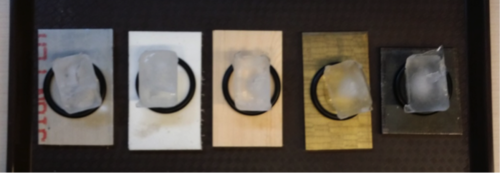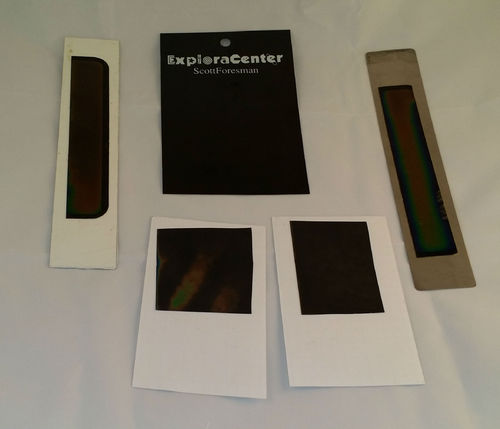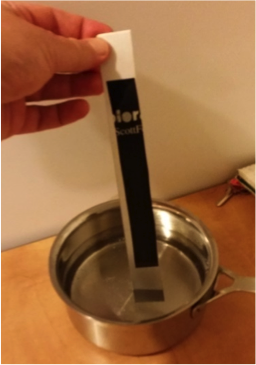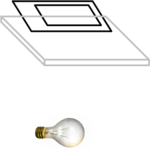I put together a series of activities to teach heat transfer. Here they are in Microsoft Word format.
 Many of them use liquid crystal thermometer plastic. They are plastic that change color as they change temperature. You've probably seen thermometers that are made this way. You can get them from a few places, but I am big fan of the 12 inch x 12 inch squares from Edmund Optical. They work well and one sheet is enough for a whole class. http://www.edmundoptics.com/testing-targets/calibration-standards/temperature-sensitive-liquid-crystal-sheets/1642
Many of them use liquid crystal thermometer plastic. They are plastic that change color as they change temperature. You've probably seen thermometers that are made this way. You can get them from a few places, but I am big fan of the 12 inch x 12 inch squares from Edmund Optical. They work well and one sheet is enough for a whole class. http://www.edmundoptics.com/testing-targets/calibration-standards/temperature-sensitive-liquid-crystal-sheets/1642
What's great about liquid crystal thermometers is that they require very small temperature changes to have a noticeable change.

Activity H1.01 Five plates – aluminum, plastic, wood, brass, and steel -- of similar dimensions are arranged as shown above. An identical ice cube is placed on each plate with a rubber o-ring keeping the ice cubes from sliding off.

Activity 2.01 You have a white index card with a liquid crystal thermometer on the top. Discover what it does when you hold it between a thumb and a finger, let it go and hold it in the air, hold it again and then put the bottom against a table, press your thumb against it while it is on the table.

Activity 2.02 A piece of the liquid crystal thermometer is glued to a thin piece of aluminum. The LC thermometer starts off black. If the end of the thermometer is placed into warm water what will happen to the color of the thermometer?
Activity 2.03 You are given a piece of steel or a piece of plastic with a liquid crystal thermometer glued on. Will it conduct at the same speed as the aluminum?

Activity 3.01 A 100 watt incandescent light bulb is attached to a stand. You hold your index card with liquid crystal thermometer glued to it 15 cm below bulb but facing the bulb. Do not have the index card touch the table. How will the liquid crystal thermometer change, if at all?

Activity 3.02 Place the index card against the table so that the liquid crystal thermometer turns black again. Hold your index card with liquid crystal thermometer glued to it 15 cm below bulb but facing the bulb. Do not have the index card touch the table. Quickly place a pen above the card so that it casts a shadow on the card. Don’t have the pen touch the card. How will the liquid crystal thermometer change, if at all?

Activity 4.01 A 100 watt incandescent light bulb is attached to a stand. You hold your index card with liquid crystal thermometer glued to it 15 cm ABOVE the bulb but facing the bulb. How will the liquid crystal thermometer change, if at all? Will it be faster or slower than before?

Activity 4.02 A 100 watt incandescent light bulb is attached to a stand. You hold your index card with liquid crystal thermometer glued to it 15 cm ABOVE the bulb but facing the bulb. Place a piece of acrylic above between the card and the bulb. Don’t touch the card with the acrylic. How will the liquid crystal thermometer change, if at all? Will it be faster or slower than before?
Activity 5.01 You put on a rubber glove. You dunk your hand in ice water and determine roughly how long it takes before your hand gets to cold hold underwater. You cover your hand with Crisco and place it underwater again. Will you be able to hold your hand underwater for less time, the same time, or for more time?
Article originally appeared on Hands On Science (http://www.kossover.net/).
See website for complete article licensing information.
 Many of them use liquid crystal thermometer plastic. They are plastic that change color as they change temperature. You've probably seen thermometers that are made this way. You can get them from a few places, but I am big fan of the 12 inch x 12 inch squares from Edmund Optical. They work well and one sheet is enough for a whole class. http://www.edmundoptics.com/testing-targets/calibration-standards/temperature-sensitive-liquid-crystal-sheets/1642
Many of them use liquid crystal thermometer plastic. They are plastic that change color as they change temperature. You've probably seen thermometers that are made this way. You can get them from a few places, but I am big fan of the 12 inch x 12 inch squares from Edmund Optical. They work well and one sheet is enough for a whole class. http://www.edmundoptics.com/testing-targets/calibration-standards/temperature-sensitive-liquid-crystal-sheets/1642





